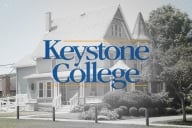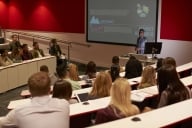You have /5 articles left.
Sign up for a free account or log in.

The most common first-year seminar content objectives are academic success strategies, institutional knowledge of campus resources and sense of belonging with the institution and campus, according to the National Resource Center for the First-Year Experience and Students in Transition survey.
FG Trade/E+/Getty Images
SEATTLE—Among colleges and universities that provide a first-year seminar course, the largest share prioritize academic skills and strategies, according to preliminary data from the 2023 National Survey on the First-Year Experience, shared Feb. 19 here at the 44th Annual Conference on the First-Year Experience and Students in Transition.
The survey, conducted by the University of South Carolina’s National Resource Center for the First-Year Experience and Students in Transition, pulled insights from 334 institutions across the nation to understand how colleges are offering their first-year seminar programs and who is impacted by that work.
During a conference session, Jamil D. Johnson, the center’s associate director, shared some of the raw data on first-year seminar courses, academic advising in the first year and common-reading programs. The center plans to further disaggregate and investigate the data over the coming months, with hopes to release a brief later this year and a larger text following that.
Methodology: Last administered in 2017, the new survey was conducted between May 2023 and September 2023 and captured data from staff and administrators at 334 institutions, representing all 50 states and Puerto Rico.
One in five institutions were minority-serving institutions (ANNH, AANAPISI, HBCU, HSI, PBI). The largest number of institutions were four-year public institutions (40 percent), followed by private four-year institutions (37 percent) and public two-year institutions (21 percent), and fewer than 1 percent were for-profit institutions.
Questions focused on seven initiatives within the first-year experience: common-reading programs, early alert warning programs, first-year academic advising, first-year learning communities, first-year residential programs and initiatives, first-year seminars, and preterm orientations.
First-year seminars: Around 77 percent of institutions offer some type of first-year seminar, a five-percentage-point increase from 2017 data. However, this number has shrunk since 2009 (87.5 percent) and 2012 (89.7 percent).
“What this is telling us is there is institutional buy-in on the first-year experience,” Johnson said.
Over half (51 percent) of first-year seminars focus on basic academic skills, including grammar, note taking and reading texts. The second most popular format is an academic seminar with uniform content across sections. These courses are themed or may be interdisciplinary and sometimes are included in a general education requirement. Fewer than one-fifth (17 percent) of institutions offer an “extended orientation” seminar, covering topics such as campus resources and how to succeed at the institution.
The most common course objectives are academic success strategies (52 percent), institutional knowledge of campus resources (34 percent) and sense of belonging with the institution and campus (38 percent). Fewer than 5 percent of respondents (4.2 percent) have diversity, equity and inclusion as a course objective.
Course content also trended toward academic offerings, with institutions prioritizing academic success strategies (28 percent), academic success resources (28 percent) and academic planning or advising (25 percent).
Across institutions, 47 percent require all first-year students to enroll in a first-year seminar.
Some common characteristics of first-year seminars:
- One semester (76.5 percent)
- One credit hour (39.2 percent)
- Part of gen ed requirements (58.5 percent)
- Are graded (86.5 percent award a letter grade)
- Involve peer mentors (56.5 percent)
First-year advising: Among respondents, 98.2 percent say first-year students are required to engage in first-year advising, and 38 percent say students are required to meet once each semester.
Around 27 percent of colleges and universities said their advisers have a caseload of between one and 50 students each; the next-largest sum was advisers who had a caseload of between 251 and 500 students. The national median number of advisees for a full-time adviser, as of 2011, was 296, according to NACADA data.
Since the FYE survey was last conducted, in 2017, more institutions have invested in their online advising opportunities for students. At four-year institutions, one in four offers an online advising option, up 13 percentage points from 2017. At two-year institutions, online offerings have spread from 37 percent of institutions in 2017 to 50 percent of institutions in 2023.
Common-reading programs: In 2017, 55.6 percent of institutional leaders said their students had access to a common-reading program. In 2023, that number declined to 44.8 percent.
One of the reasons for this cut is the high costs related to first-year common-reading programs, Johnson says. While common-reading programs can create space for critical scholarship, narrative voice and instilling a sense of belonging in learners, institutions have not seen a return on investment in their resources. Johnson predicts this trend will continue to decline in the future.
Get more content like this directly to your inbox every weekday morning. Subscribe here.








